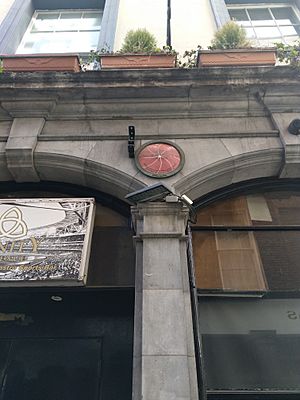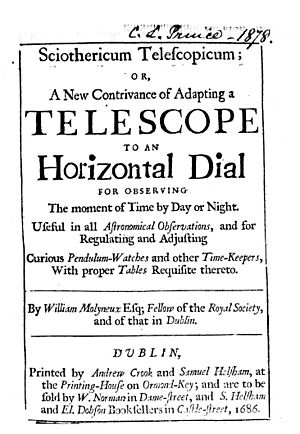William Molyneux facts for kids
Quick facts for kids
William Molyneux
|
|
|---|---|
 |
|
| Born | 7 April 1656 Dublin, The Pale, Kingdom of Ireland
|
| Died | 11 October 1698 (aged 42) Dublin, Ireland
|
| Resting place | St. Audoen's Church, Dublin (Church of Ireland) |
| Nationality | Anglo-Irish |
| Occupation |
|
| Known for | Dublin Philosophical Society |
| Spouse(s) | Lucy Domville (1678–91; her death) |
| Awards | Fellow of the Royal Society |

William Molyneux (born April 17, 1656 – died October 11, 1698) was an important Irish writer and thinker. He wrote about science, politics, and how the world works. He was from a family with both English and Irish roots, often called "Anglo-Irish."
Molyneux was a close friend of the famous philosopher John Locke. He is also well-known for creating a famous puzzle called "Molyneux's Problem." This was a "thought experiment" that people still talk about today.
Contents
Early Life and Family
William Molyneux was born in Dublin, Ireland. His father, Samuel Molyneux, was a lawyer and landowner. William was the second of five children. His family was quite well-off and belonged to the Anglican church.
William was very close to his brother, Sir Thomas Molyneux. They both shared an interest in philosophy and science. In 1671, William started studying at Trinity College Dublin. There, he loved reading books by the leading thinkers of the Scientific Revolution.
After college, Molyneux studied law in London from 1675 to 1678. In 1678, he married Lucy Domville. Sadly, Lucy became ill after their marriage, lost her sight, and died young. They had three children, but only one, Samuel Molyneux (born 1689), lived to be an adult. Samuel later became an astronomer and politician, and he worked with his father on many science projects.
Career and Writings
Because William Molyneux had money from his family, he didn't have to worry about finances. Still, he held several important jobs during his life.
Official Roles
In 1684, he became the Joint Surveyor General of the King's buildings and works in Ireland. This meant he helped oversee royal construction projects. He also served as a Member of Parliament for Dublin University from 1692 until he died.
Scientific Inventions and Publications
Molyneux was very interested in science. In 1687, he invented a new type of sundial called a Sciothericum telescopicum. This special sundial used a telescope to measure the exact time of noon.
He also wrote many books and papers. His first book was an English translation of René Descartes's work, published in 1680. He also worked with Roderic O'Flaherty to gather information for a large atlas project, collecting valuable early Irish history.
Founding the Dublin Philosophical Society
In October 1683, Molyneux started the Dublin Philosophical Society. This group was similar to the famous Royal Society in London, which Molyneux himself became a member of in 1685. He was the first Secretary of the Dublin Philosophical Society. He was very active, recording weather data, calculating eclipses, and showing new scientific tools and experiments.
His most famous scientific book was Dioptrica Nova, published in 1692. This book was all about optics, explaining how lenses work in telescopes and microscopes.
Friendship with John Locke
After John Locke published his important book, Essay Concerning Human Understanding (1690), Molyneux wrote to him to praise the work. This started a close friendship between the two philosophers.
The Case of Ireland
In 1698, Molyneux published a very important and controversial book called The Case of Ireland's being Bound by Acts of Parliament in England, Stated. This book discussed whether the English Parliament had the right to make laws for Ireland without Ireland's agreement.
Molyneux argued that Ireland should not be controlled by English laws, especially those that hurt Irish trade, like the laws against the Irish wool industry. His arguments were based on history and legal ideas.
The English House of Commons did not like Molyneux's book at all. They said it was "dangerous" because it questioned the authority of the English King and Parliament over Ireland. Even though Molyneux was not punished, his book was officially condemned. It was even burned in public by the hangman in London.
Despite this, Molyneux's ideas remained important in Ireland. They influenced later Irish thinkers and even caught the attention of the American colonies as they moved towards independence. It's important to know that Molyneux was not trying to make Ireland completely separate from England, but he wanted Ireland to have more control over its own laws.
Legacy and Molyneux's Problem
Molyneux is still remembered for his famous philosophical question, known as Molyneux's Problem. He asked John Locke: If a person born blind could suddenly see, would they be able to tell the difference between a cube and a sphere just by looking at them, without touching them? This question has been debated by philosophers and scientists for centuries.
The University Philosophical Society at Trinity College Dublin sees itself as the modern version of the Dublin Philosophical Society that Molyneux founded. They recognize him as their founder and first president.
William Molyneux died in Dublin on October 11, 1698. He was buried in St. Audoen's Church.
Works



